Having a eye for the next great fly tying material is one thing, ideas being the easiest part of the larger riddle, it’s the destruction and transformation that is the real test of invention.
I’ve discovered the next great dry fly dubbing; filament size smaller than the finest materials currently available, specific gravity less than 1.0 – so it floats naturally, and wants to stick to thread so badly that static from your fingers is nearly enough to wind it tightly around unwaxed thread…
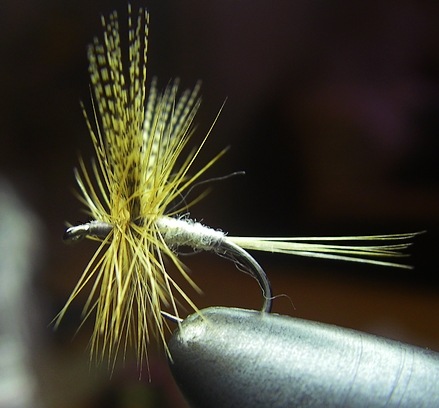
I’ve got visions of groupies and dinners at the White House, getting the “hale fellow well met” glad-hand from the current anglers of legend, and never having to pay for drinks again…
… there’s just this teensy little problem I have …
I have to destroy it to make it.
Blenders can’t dent it, acid melts it, and dragging it behind my truck works – but I can’t tie enough to the bumper to create a snowstorm of filaments that I can scoop off the neighbor’s lawn.
I’m doing battle with some Ph.D fabric engineer who saw a great cloth and spent months ensuring it’d never unravel. He didn’t realize some idiot fly tyer would delight in destroying his best work for the sake of dampening it in a trout stream.
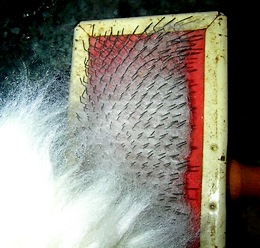 The first sign of progress was the judicious use of “Old Tailwagger.” It’s right after blenders in the fly tying book of mass destruction. Blenders excel on yarn, but fabric requires torture to become fibrous, and the Tailwagger is the tool of choice for stressing tightly woven filaments.
The first sign of progress was the judicious use of “Old Tailwagger.” It’s right after blenders in the fly tying book of mass destruction. Blenders excel on yarn, but fabric requires torture to become fibrous, and the Tailwagger is the tool of choice for stressing tightly woven filaments.
The downside being everything four legged is your new best friend. I use a brown paper bag to smuggle it past the family pets – which possess a sixth sense for leashes, brushes, and trips to the refrigerator.
The above picture shows the results of stressing a “panel” of material and rendering it from flat and lifeless – to a veritable sheepdog of fiber.
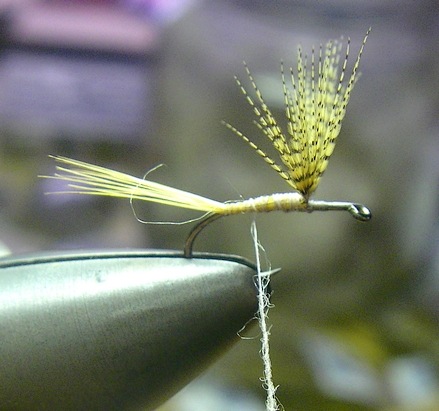
As I’m still possessed by the Catskill dry (due to Mike Valla’s book) the above shows a single filament of the dubbing contrasted against the tail fibers of a Light Cahill. The filament size is only about 1/8 of the width of a single hackle barbule.
That’s nearly microscopic.
That translates into a tiny dry fly body – and much less water absorption than normal. Wings and bodies have always proven the nemesis of dry flies as they’re the only materials that don’t assist in flotation. Smaller amounts of dubbing assists both classic dry and their scientific cousins in remaining afloat.
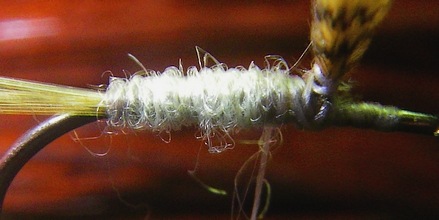
For the aspiring dry fly fiend this solves one of the more troublesome problems. How to dub a tight thin body that’s neither lumpy nor absorbs extra water. The above magnification shows the complete dubbed Light Cahill, albeit poorly, there’s almost no build up of material when compared to the raw thread area behind the wing.
… and why I spent the better part of this weekend transforming the material into something usable.
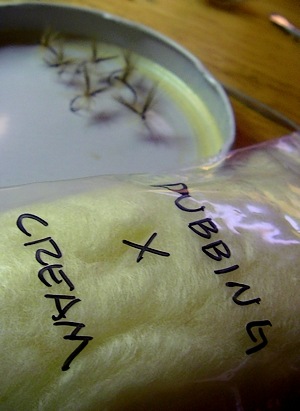
Now all the fun starts. Dyeing the material into the most common 15-20 colors used for dry flies – additional tinkering with blended colors – and I may attempt to mix it with larger-fibered beaver or muskrat just to gauge the effect.
Microscopic fibers don’t blend well using machinery. Only water shaken vigorously can act as the blending agent. Blender blades and agitators just clump the fiber like cotton candy.
It’ll take some time to pick the colors and render mass quantities of material, but Winter is plenty long and this type of project is just what’s needed when football grows dull.
Those of you who fancy the dry fly might want to drop me a note. I’d be happy to send out some samples when I get a couple nice Olives and a medium Gray, as I’ll be looking for some feedback on both the material and colors. Refining a raw product takes a great deal of tinkering, patience, and time.
Tags: dubbing, classic dry flies, Light Cahill, dry fly dubbing, fly tying materials, fly tying

How does one “drop you a note” and what denomination note does one drop for a sample?
I’d sure like to try this nano-fiber dubbing once you have enough to share.
I can send you some of the cream color to test. Just send me an email with your mailing address… if you dare…
Simply click the “Sixth Finger” picture at the top of the page – it should load your email application and address the message to me automatically.
Received your package yesterday. Your dubbing is great and just as you described. I’d say that stuff is smooth as a young maiden’s thighs!!
Thanks for the Angelina! That stuff is going to make some wicked buggers for Pyramid Lake!
Check is in the mail for the “Sixth Finger”. Sweeeeet!!!!
Glad to be of service, BigDewy